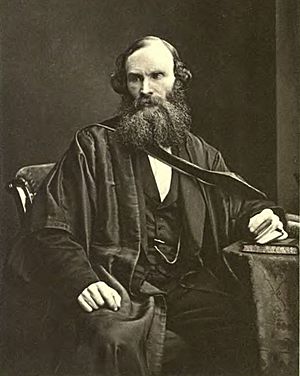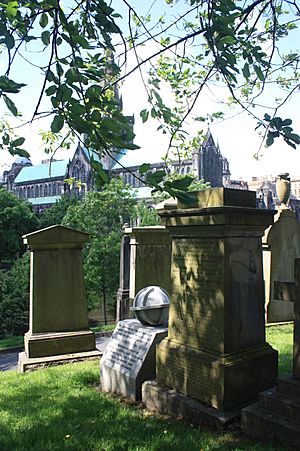James Thomson (engineer) facts for kids
Quick facts for kids
James Thomson
|
|
|---|---|

Photo of James Thomson (1822–1892) taken from the book Collected Papers in Physics and Engineering by James Thomson.
|
|
| Born | 16 February 1822 |
| Died | 8 May 1892 (aged 70) |
| Known for | Ball-and-disk integrator Differential analyser Tea leaf paradox Tears of wine |
| Awards | Bakerian Medal (1892) FRS (1877) |

James Thomson (born February 16, 1822 – died May 8, 1892) was a clever British engineer and physicist. He was born in Belfast and was the older brother of the very famous scientist, Lord Kelvin. James Thomson made important discoveries about water, ice, and how things move.
Contents
Life and Education
James Thomson spent most of his childhood in Glasgow. His father, also named James, was a mathematics professor. He taught at the University of Glasgow starting in 1832. James's younger brother, William, later became the famous Lord Kelvin.
James started attending Glasgow University when he was quite young. He graduated in 1839 with excellent grades. After university, he worked briefly with engineers. He spent a lot of time studying engineering and mathematics. He often worked with his brother during these years.
Becoming a Professor
In his late twenties, James Thomson started his own engineering business. He was especially good at designing systems for water transport. In 1855, when he was in his early thirties, he became a professor. He taught civil engineering at Queen's University Belfast.
He stayed in Belfast until 1873. Then, he accepted a new job at the University of Glasgow. He became the Regius Professor of Civil Engineering and Mechanics. He took over from a very important engineer named William Rankine. James Thomson worked there until 1889, when he had to stop due to his eyesight.
Honors and Recognition
In 1875, James Thomson was chosen as a Fellow of the Royal Society of Edinburgh. This is a big honor for scientists. His brother, William Thomson, was one of the people who suggested him.
He was also elected a Fellow of the Royal Society of London in June 1877. This is another very important scientific group. From 1884 to 1886, he was the President of the Institution of Engineers and Shipbuilders in Scotland.
James Thomson passed away in Glasgow on May 8, 1892. He is buried in the Glasgow Necropolis. People remembered him as a kind and honest person.
Scientific Discoveries
James Thomson is well-known for improving water wheels, water pumps, and turbines. These machines use the power of water to do work. He also made important discoveries about how pressure affects the freezing point of water.
Understanding Ice and Glaciers
He studied something called regelation. This is when ice melts under pressure and then refreezes when the pressure is removed. He also researched glaciology, which is the study of glaciers. He helped explain how glaciers move, building on earlier work by James David Forbes.
Liquids, Gases, and the Triple Point
Thomson also looked at the work of his friend Thomas Andrews. Andrews studied how liquids and gases are connected. Thomson used his strong knowledge of thermodynamics (the study of heat and energy) to explain this better.
He simplified a scientific equation called the Clapeyron equation. This equation helps describe the boundary between a solid and a liquid. He also came up with the term triple point. This describes the exact conditions (temperature and pressure) where a substance can exist as a solid, liquid, and gas all at the same time.
Fluid Dynamics and Torque
James Thomson also contributed to the study of how rivers flow. This is called fluid dynamics. It is also believed that he introduced the word torque into English science in 1884. Torque is a twisting force that causes rotation.
See also
- Marangoni effect
- Rayleigh–Bénard convection

